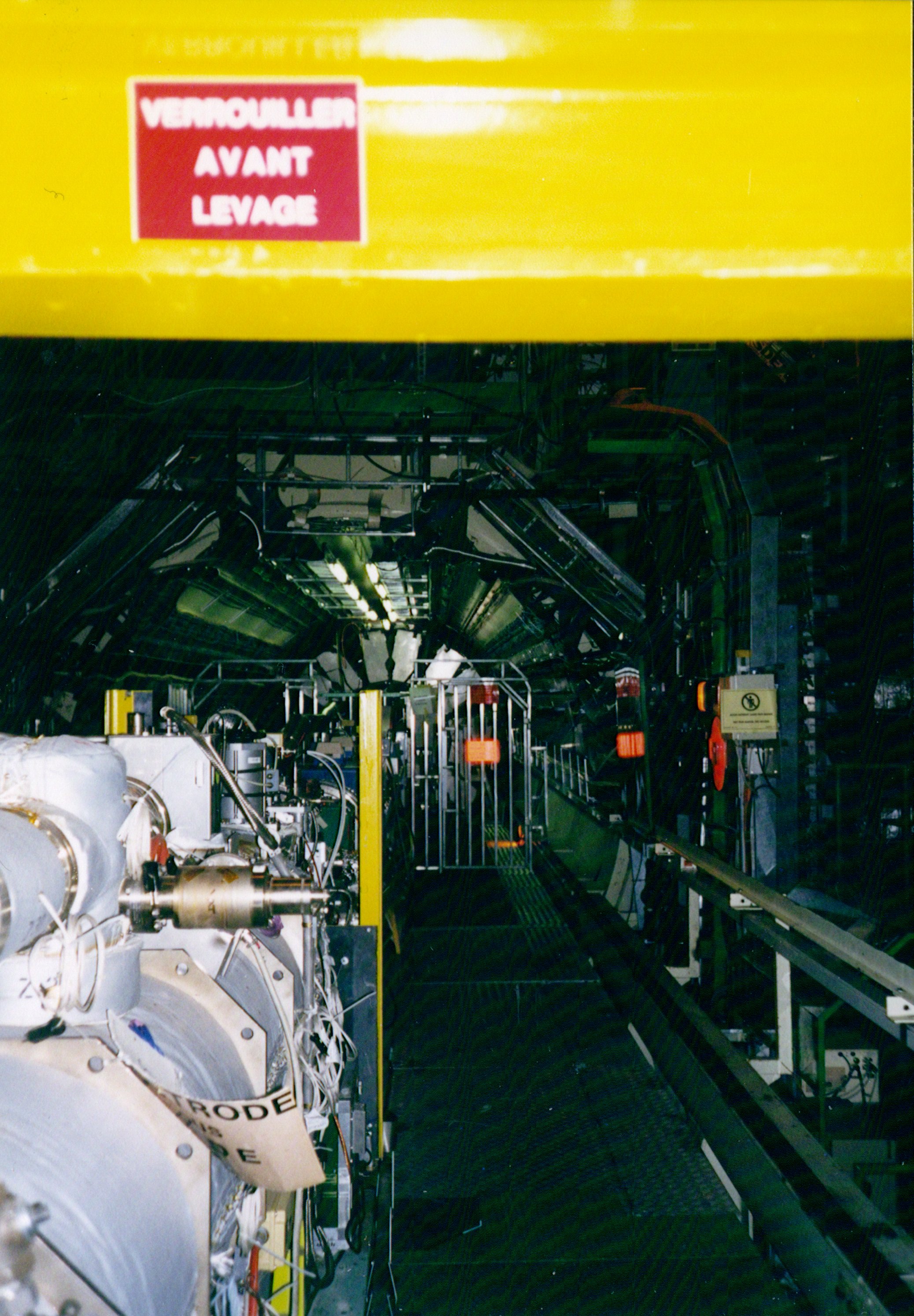
Nuclear physic... One of the most interesting physical themes which tries to conclude
from the smallest particle and its behavior to the big bang theory and the further
development of the universe.
For a better understanding and to round off the theme, we, the pupils of the
physics basic and advanced course in the 13th class from
the "Brandenburgischen Schule für Blinde und Sehbehinderte",
decided to visit one of the biggest center of those nuclear researches, the CERN,
near Geneva.
The following account shall show what we’ve learnt and experienced there.
 CERN’s newest particle accelerator is the large electron-positron collider (LEP)
with an accelerator and collision circle of 27 km length. With LEP, positrons
and electrons can almost be accelerated to the speed of light. DELPHI, one
of the four LEP particle detectors, consists of a horizontal cylinder with
a diameter of ten meters and a weight of 3.000 tons. A large hadron collider
shall be accommodated in the LEP-tunnel. In 1994, the member countries granted
3.1 million DM for it.
CERN’s newest particle accelerator is the large electron-positron collider (LEP)
with an accelerator and collision circle of 27 km length. With LEP, positrons
and electrons can almost be accelerated to the speed of light. DELPHI, one
of the four LEP particle detectors, consists of a horizontal cylinder with
a diameter of ten meters and a weight of 3.000 tons. A large hadron collider
shall be accommodated in the LEP-tunnel. In 1994, the member countries granted
3.1 million DM for it.
How does it work?
The particles are accelerated to very high energy. When particles
collide or clash on "targets", physicists can
analyze the reaction and discover the forces, which exist between the particles.
There are two kinds of accelerators, linear and circular accelerators.
CERN has got both types at its disposal. Accelerators use high electric
fields in order to charge a particle beam with energy. Magnetic fields
focus the beam and on a circular accelerator, they band it on orbit.
In a linear accelerator, the beam is charged with energy at the whole
length of the machine. The longer the accelerator is, the higher is the energy.
Detectors are like cylindrical onions. Collisions take place close to the middle,
and different layers of detectors measure different properties of the emerging
particles. The precision tracking devices are closest to the beam, which pinpoint
particle tracks with a
thousandth-of-a-millimeter precision. These are surrounded with less exact,
but vastly bigger trackers to keep tubs on the particles as they fly away
from the collision. Further out there are energy measuring devices, calorimeters,
in which most particles finish their journey. The final layer consists of
trackers again, this time to identify the only detectable particles, which
get this far, the weakly interacting muons. A magnet embedded within the
detector bends the tracks of charged particles, helping to identify and
measure individual ones.
In case of particle collisions in accelerators or their clashes on "targets"
outside the accelerator, new particles come into being. At this time matter
converts into energy, and energy converts back into matter again, appropriate
to Einstein’s famous formula E=mc².
However, it’s important that in a particle collision energy is
concentrated on tiniest room. From such extremes energy concentration,
new particles come into being which we need to
analyze to get new insights into the secrets of nature.
What is a particle accelerator?

Particle accelerators are physical and technical facilities used for accelerating
charged elementary particles. Particle accelerators belong to the biggest and most
expensive physical devices which bring particles to a high speed. On the whole,
these facilities consist of three components: a source from which the elementary
particle beams start, a largely evacuated and cylindrical railway in which the
particles can move freely and a unit to accelerate the particles. Usually,
accelerators are combined with other facilities, for instance particle detectors.
Charged particles can be accelerated with the help of electric fields.
What are particle detectors?
Particle detectors are devices or facilities used to prove and study elementary particles. Detectors can either be small and simple, or they can be very big and complex. They can even reach the size of a room, a flat or a house.
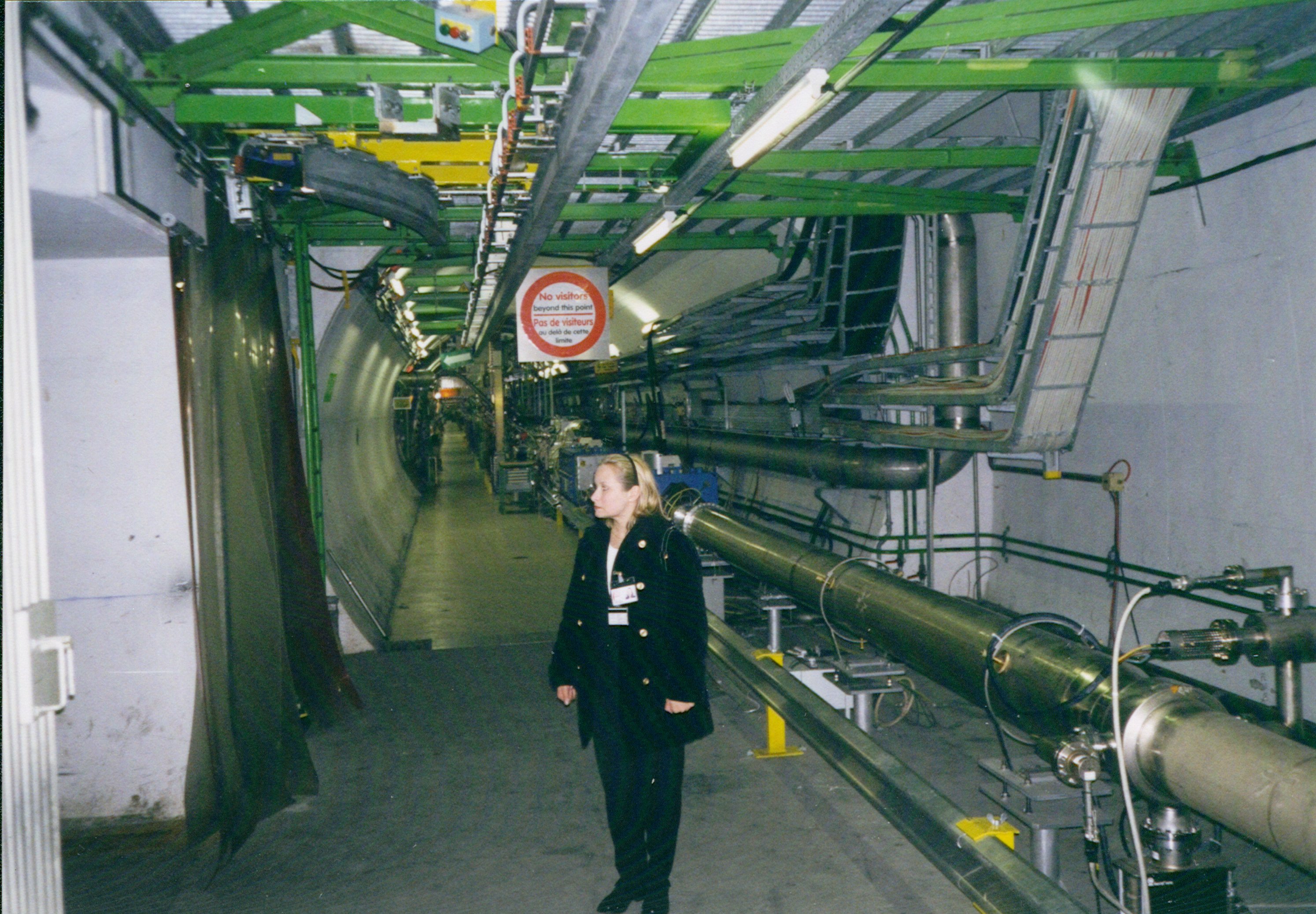 The large Electron Positron Collider, LEP, is the world’s largest particle
accelerator. Built inside a circular tunnel, it is 27 km round und buried 100
meters underground. At four points around the accelerator, huge detectors,
called ALEPH, DELPHI, L3 and OPAL, study what happens when electrons and
their antimatter counterparts, positrons, collide at high energy.
The large Electron Positron Collider, LEP, is the world’s largest particle
accelerator. Built inside a circular tunnel, it is 27 km round und buried 100
meters underground. At four points around the accelerator, huge detectors,
called ALEPH, DELPHI, L3 and OPAL, study what happens when electrons and
their antimatter counterparts, positrons, collide at high energy.
How do accelerators work?
Particle accelerators like LEP work by exploiting the way charged particles
move in electric and magnetic fields. Electric fields accelerate them.
Magnetic fields bend and focus them into beams.
All particle beams start from a particle source. The simplest
source is a hot wire, like the filament inside a light bulb. This
is the kind of source used by televisions.
A similar filament is also used in the Linear Injector for LEP,
LIL. LIL is a linear accelerator, linac for short, which prepares LEP’s beams.
In a linac, particles accelerate from one electrode to the next, gaining energy
with each one they pass. LIL’s filament produces LEP’s electrons,
but producing positrons is a little trickier. To provide the positrons,
electrons are accelerated through a foil, where they cause pairs of
electrons and positrons to be created. The positrons are selected by magnets
and stored until they are enough of them to form a beam. All of CERN’s beams
begin their lives in linacs, but to reach the energies that physicists need
would require extremely long accelerators. For this reason, CERN’s big
machines are circular. Particle beams travel round and round gaining energy
with each lap. In LEP, 3368 magnets bend the particle beams and keep them on orbit.
What does LEP do?
LEP was designed to study one of nature’s fundamental forces,
the weak force which fuels
the sun, and is responsible for some forms of radioactivity.
One of the first results to come from LEP is also one of the most profound.
LEP has shown that matter comes in three distinct "families" of
particles. All of the things we see around us, ourselves included, are made from
particles belonging to the lightest of these families. The other two are
just heavier copies of the first.
Why there are three families, instead of just one, is still a mystery.
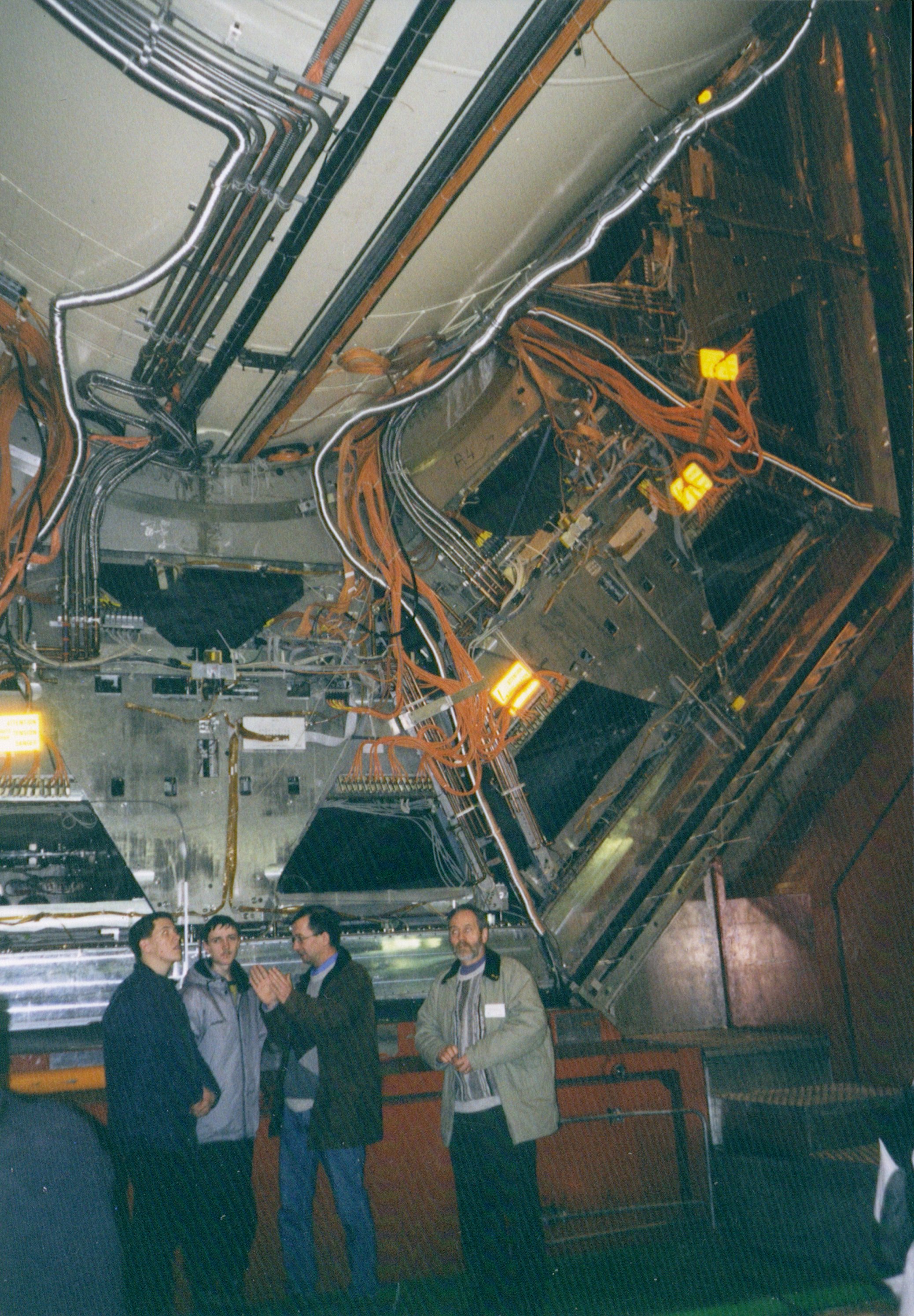 How do we use the four detectors?
How do we use the four detectors?
The four LEP detectors work on one and the same basic principle, but each is optimized with a different goal in mind. OPAL is based on well-understood techniques, to guarantee results right from the start. DELPHI is at the other extreme, packed with innovative technology. ALEPH takes the middle line, whilst L3’s design is optimized for muon detection. All four have worked impeccably, and friendly rivalry has spurred on the collaborations of physicists who built them to the dominant place they hold in particle physics today.
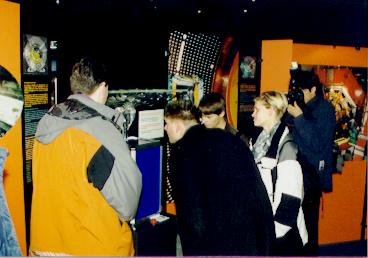 many discussions about universe, matter, infinity, speed of light etc.
and a seventeen-hour long ride by train, the most important day of this trip started.
On Monday, the 24th of January 2000 at 9 o‘clock a.m., our guided tour began
with a lecture by Dr. Schäfer, an employee of L3. With the help of some basic questions,
for instance: "What is CERN?" or: "How do scientist work in this facility?"
he explained CERN’s functions and aims to us. Like in the Mr. Schöneich’s lecture,
his report was very interesting, detailed and comprehensible. And of course, it was
very good that it was perfectly arranged also for our blind classmates.
During this lecture, in the following guided tours and exhibitions he
answered all our questions. Our complicated questions led to interesting,
and instructive discussions with Dr. Schäfer.
many discussions about universe, matter, infinity, speed of light etc.
and a seventeen-hour long ride by train, the most important day of this trip started.
On Monday, the 24th of January 2000 at 9 o‘clock a.m., our guided tour began
with a lecture by Dr. Schäfer, an employee of L3. With the help of some basic questions,
for instance: "What is CERN?" or: "How do scientist work in this facility?"
he explained CERN’s functions and aims to us. Like in the Mr. Schöneich’s lecture,
his report was very interesting, detailed and comprehensible. And of course, it was
very good that it was perfectly arranged also for our blind classmates.
During this lecture, in the following guided tours and exhibitions he
answered all our questions. Our complicated questions led to interesting,
and instructive discussions with Dr. Schäfer.
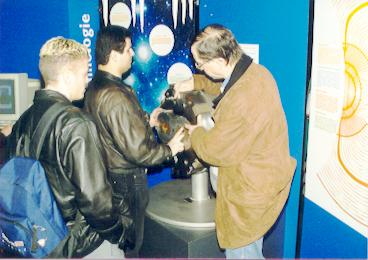 After the lecture we visited the exhibition Microcosm, which was informative, too.
Here we found a very good graphic description about the big bang theory and the
development of the universe, a Calorimeters, which is used for the measurement of
impulses, different detectors mock-ups and some separate accelerator components,
for instance the resonator.
After the lecture we visited the exhibition Microcosm, which was informative, too.
Here we found a very good graphic description about the big bang theory and the
development of the universe, a Calorimeters, which is used for the measurement of
impulses, different detectors mock-ups and some separate accelerator components,
for instance the resonator.
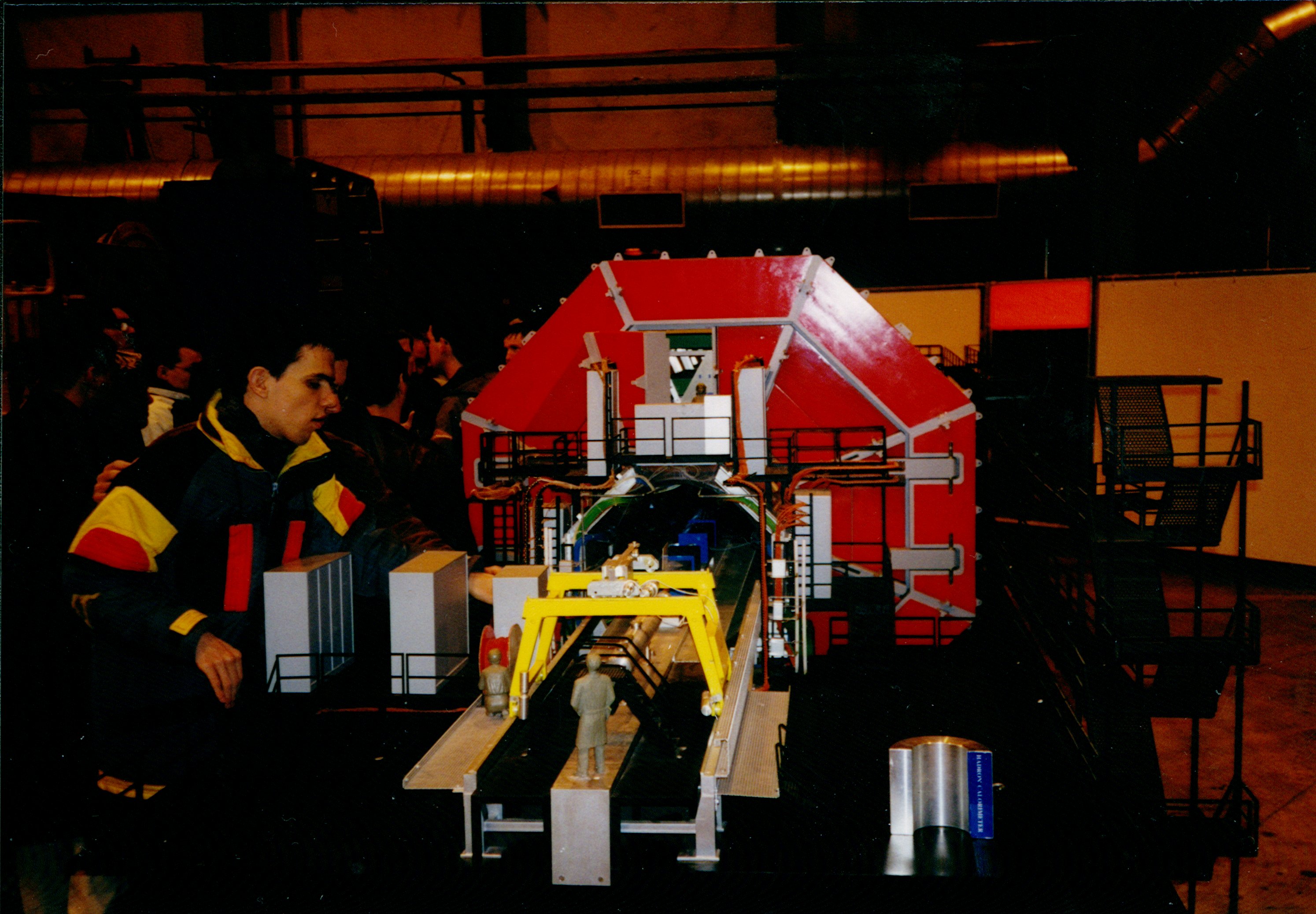 The bus arrived on the parking place, and we went off to the experiment L3.
When we arrived there, we were very impressed because many preparations had
already been done. First we looked at a model of the experiment.
Dr. Schäfer explained its necessities and essentials. This model
is traced in a scale of one to ten. Our blind classmates could also get
a good impression of the experiment because they had the opportunity to touch the model.
The bus arrived on the parking place, and we went off to the experiment L3.
When we arrived there, we were very impressed because many preparations had
already been done. First we looked at a model of the experiment.
Dr. Schäfer explained its necessities and essentials. This model
is traced in a scale of one to ten. Our blind classmates could also get
a good impression of the experiment because they had the opportunity to touch the model.
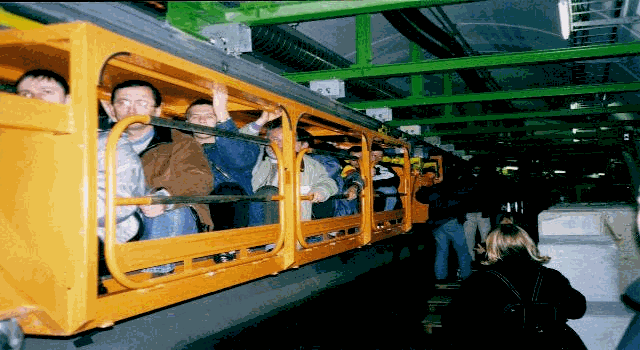 Another outstanding experience waited for us. After having seen almost
everything of L3, we were allowed to enjoy a ride with the service rail which was
organized only for us. We climbed into the rail – they had set up a scaffold
platform especially for us – and we went 300
meters into the LEP-tunnel. Usually, visitors mustn’t do something like this.
It was also for our guides something new. Here in the LEP-tunnel, we saw the
several magnets and the very, very big number of cables, pipes and lines.
Another outstanding experience waited for us. After having seen almost
everything of L3, we were allowed to enjoy a ride with the service rail which was
organized only for us. We climbed into the rail – they had set up a scaffold
platform especially for us – and we went 300
meters into the LEP-tunnel. Usually, visitors mustn’t do something like this.
It was also for our guides something new. Here in the LEP-tunnel, we saw the
several magnets and the very, very big number of cables, pipes and lines.
Brandenburgische Schule für Blinde und Sehbehinderte
15711 Königs Wusterhausen
Luckenwalder Straße 64
Telefon: 03375 2429-11
Thomas Schrowe (Physics advanced course, 13th class)
Monique Gartmann, Marko Weber (Physics basic course, 13th class)